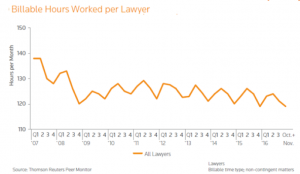Last month I posed the question, “What if you didn’t hit budget in 2016?” This month, I want to look forward into 2017 and offer some prospective advice to help leadership teams either hit budget or optimally manage expectations in the event of a miss.
These thoughts are based on studying an existing performance metric that (I think) demonstrates that the first two quarters of the year are the most important, from a production perspective, and set the stage for how the year will end up.
A metric in this discussion is important because, upon further examination of some firms that came up short last year, I am hearing that a large segment of the Partnerships had become immune to the messaging related to the perils of year-end. As one astute Partner explained, “every year we got the same gloom and doom projections and warnings and then management would cut expenses or something else would happen and we would have another one of our best years ever. We were told every year in November and December that the sky is really falling this year but it never fell…until last year”.
Here is the critical industry metric/bellwether for this situation (from Thomson Reuters Peer Monitor, as presented in the 2017 Report on the State of the Legal Market by the Georgetown Law Center for the Study of the Legal Profession) –

While this chart shows a gradual downward trend in hours per month per lawyer, which is noteworthy, I am focusing here on the repeating, annual pattern presented above. Look at the peaks. In each year the billable hours worked per lawyer peaks in either the first or (most often) the second quarter. Intuitively, this annual pace of work in a seasonally repeating pattern makes sense – wake up and ramp up in Q1, peak in Q2, go on vacation in Q3, and collect like a maniac in Q4.
As with any performance metric, there are many underlying/contributing factors that affect this one, such as capacity management (Is dead wood being tolerated?) and the realizable value of this time (Will these accrued efforts actually turn into cash?) and these influences need to be understood. That said, the key message I see in this data set is that the first half of the year is simply our make-or-break period because there is little make-up-ability in the second half.
This concept is important right now because we are starting Q2, which is halfway through the critical period for 2017. In three months the industry’s bellwether performance period will be over, and much of this year’s outcome will be set. It’s time to start planning how to read this data and manage the resulting conclusions. Consider the following roadmap –
- Create this historical chart for your firm now so your leadership team can start tracking this information. Include a projection for 2017 based on your budget and track this both monthly and with a quarterly “roll-up” to compare to the industry data (above). Does your firm track the seasonal industry pattern?
- If your firm generally follows the industry pattern, schedule leadership meetings to discuss progress on May 15 and June 15. If performance is slipping against expectations, start developing your recovery strategies and, if needed, implement them immediately.
- Schedule a leadership “summit” in early July to critically review performance against budget. Publicize this meeting so the Partners know that the leadership team is focused on this issue. If hours tracked are materially below expectations and no extraordinary events are realistically expected in the second half, then immediately develop a plan with related communications to guide the firm through the following months.
If a likely shortfall against budget exists, you will be able to take a hard, metric-based message to the Partners to incentivize them to move…rather than the same tired message they have heard and ignored for many years prior. (Of course, if you are trending positively on this metric and it looks like you will meet or exceed budget then you will probably need to use the same tired messages as in the past!)
I know that some law firm leaders will ask, “won’t taking bad news to the Partners at mid-year scare some of them and potentially de-stabilize the firm?” While there are no universally correct answers in our business, I think that potential issues should be addressed as early as possible. If the year ends well then confidence in leadership is boosted. If the year ends poorly but the Partners were warned and know that leadership did what they could then confidence is maintained. If the year ends poorly and the Partners are surprised, then confidence is eroded…even if leadership did what they could to save the situation.
I am often told that, “we have no idea how the year is going to end up until December 31.” While this is true for the official financial results that sometimes include miracles, I think this metric provides us with a reasonable basis for modeling and predicting the rest of the year. Take advantage of this bellwether.
Posted In

